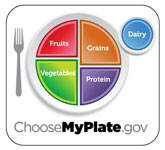

In response to growing concerns over obesity, recent national attention has focused on the need to establish nutrition standards in schools. In January 2012, the United States Department of Agriculture – Food and Nutrition Service division released Nutrition Standards in the National School Lunch and School Breakfast Programs; Final Rule. This ruling was a part of the original Healthy, Hunger-Free Kids Act (HHFKA) of 2010; championed by First Lady Michelle Obama.
The Institute of Medicine (IOM) advises Congress on matters relating to health and science, and was instrumental in providing data utilized in the development of the Nutrition Standards Final Ruling. Many of the changes in the final ruling were largely based on the IOM recommendations outlined in the “School Meals: Building Blocks for Health Children” report.
The school environment is one of several settings that can influence children’s food choices and eating habits. Therefore, meals should be designed to ensure that the foods offered meet or exceed the recommendations. In addition, staff should serve as role models for students by demonstrating healthy food and physical habits. The following are several key requirements set forth by the USDA to improve school lunch and breakfast beginning with the 2012-2013 school year:
- default_titleOffer a variety of fresh produce to include those prepared without added fats, sugars, refined sugars, and sodium
- default_titleOffer a variety of vegetables daily to include specific subgroups as defined by dark green, red/orange, legumes, and starchy
- default_titleOffer whole grain products – half of all grains need to be whole grain-rich upon initial implementation and all grains must be whole grain-rich two years post implementation
- default_titleOffer fluid milk that is fat-free (unflavored and flavored) and low-fat (unflavored)
- default_titleOffer meals that are designed to meet specific calorie ranges for age/grade groups
- default_titleEliminate trans fat from school meals
- default_titleRequire students to select a fruit or vegetable as part of a complete reimbursable meal
- Show More
USDA recognized the significance of these changes and provided an implementation timeline upon the release of the Final Ruling. The majority of the changes are expected to be implemented within the first five years, with the first year of implementation taking place during the 2012-2013 school year.
The School Food Service (SFS) Department established a team of individuals to thoroughly review the Nutrition Standards in the National School Lunch and School Breakfast Programs; Final Rule. Collectively, this team determined the procedures in which to implement the required changes, and the strategies in which to communicate them.
Below is a list of strategies which the SFS Department will be utilizing during the 2012-2013 school year to communicate the changes:
- default_titleHost mandatory trainings for all SFS employees to attend
- default_titleCreate marketing flyers
- default_titleSubmit an internal district bulletin for principals and assistant principals
- default_titleIncorporate information into all menus (breakfast and lunch)
- Show More
The SFS Department continually implements changes to offer students the opportunity to consume a well-balanced meal. For years, the department has researched the market to secure items that are nutritionally enhanced; providing students with a variety of fruit and vegetable choices, whole grain-rich options, and a choice of low-fat and fat-free milks. Since USDA unveiled the changes, manufacturers are reformulating their products to meet the new standards and ultimately improve the nutritional integrity of school meals across the nation. The SFS Department plans to incorporate some of these new products into its menus for the upcoming school years.
Body Mass Index (BMI) is a standard that can be applied to most people in order to define obesity. BMI is calculated from a person’s weight and height and is often used to screen for weight categories that may lead to health problems.
Weight Categories based on BMI
BMI
Weight Status
Below 18.5
Underweight
18.5-24.9
Normal
25.0-29.9
Overweight
30.0 and Above
Obese
Calculating BMI
Measurement Units
Formula and Calculation
Kilograms and meters (or centimeters)
Formula: (weight (kg) / [height (m) x height (m)])
Pounds and inches
Formula: (weight (lb) / [height (in) x height (in)]) x 703
Recent data from the Centers for Disease Control (CDC), indicates that 1 out of every 3 children are obese or overweight before their 5th birthday. When children are overweight or obese they are more likely to have high blood pressure, high cholesterol, and type 2 diabetes. In addition, they are more likely to become obese adults. Unfortunately, the latest Youth Risk Behavior Survey reported 12% of Florida students were obese. Now is the time to educate these students and encourage the development of healthy eating habits.
MyPlate and the 2010 Dietary Guidelines for Americans, both supported through the USDA, are resources that Americans can use to make healthy food choices and be physically active every day.
- default_titleMyPlate is split into four sections each representing a different type of food – protein, whole grains, fruits, vegetables, and dairy. The sections vary in size depending on the recommended portion, with dairy included on the side. This food guidance system promotes energy balance by enjoying your food and avoiding oversized portions. It also encourages increasing fruits and vegetables by filling half the plate with food from those groups, making half of all grains whole grains, and switching to fat-free low-fat milk.
- default_titleThe Dietary Guidelines for Americans focuses on balancing calories with physical activity and encourages Americans to consume more healthy foods like vegetables, fruits, whole grains, fat-free and low-fat dairy products, and seafood while reducing their intake of sodium, saturated fat, trans fat, added sugars, and refined grains.
- Show More

